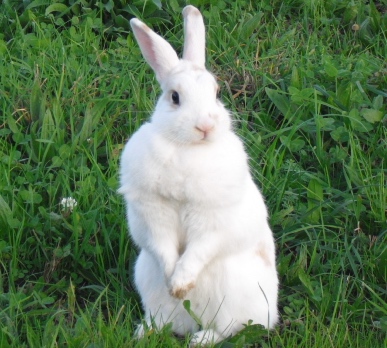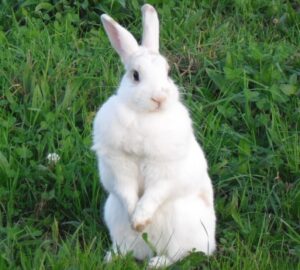

MAGIC FINDS A MATE: A RABBIT ROMANCE STORY
In spring, a young rabbit’s thoughts turn to love (even if he’s been neutered), and that was the case for Magic, a pure white bunny who got his name because he looked like he’d been pulled out of a silk top hat. His human, Chantal, scheduled a session to ask me about his desires, and a bunny girlfriend was tops on his list.
Intuitively, I sensed that Magic led a life of luxury, where he was king of the castle. He had an excellent toy-filled habitat encompassing the large kitchen area, where knee-high fencing allowed safe play, and he was trained to use a litterbox.
Bunny life for Magic included high-quality food and a watchful, loving human caretaker—everything a bunny could want, short of a girlfriend. He also had a cat friend, Cyril, who was currently in the dog house, Magic told me, because of the cat’s insistence on bringing headless rodent treats to Chantal through an open window at night.
MAGIC’S REQUEST
Magic wanted to commune with another animal of his own variety, especially one of the opposite sex, and Chantal was eager to please him.
“Magic also wants to go with you when you shop for his new friend,” I told her. “He says he’ll show you which rabbit he’s choosing.”
“Do they allow that kind of thing?” Chantal asked me.
“Usually, they do,” I said. “Just take him with you, and when you’ve picked out a couple of female rabbits, put each of them with Magic in a grassy area and see what happens.”
Chantal did just that, and the message was clear. Magic chose a jet-black bunny within just a few minutes of meeting at the rabbit rescue center. The black and white rabbits reminded their new caretaker of bunny yin and yang as they became acquainted.
“I made an appointment with a woman who knew a lot about rabbits,” Chantal reported later. “She was already aware that Magic was cage-free and lived in my kitchen, and she told me about a special sweet and submissive black rabbit. While I made plans to visit Rabbit Rescue, the proprietor told me she would help with the introductions and see how it went.”
The two women watched with amusement as they placed the two rabbits into a pen together. The black female bunny approached Magic and lay down. They looked comfortable together, and both women felt the rabbits recognized each other. Lola, the black bunny, rode home in the same carrier with Magic as more bonding took place, and Magic showed me sharing his love of riding in the car with his new girlfriend. When she returned home, Chantal let the bunnies loose into their new kitchen habitat.
“Lola hopped everywhere, and Magic followed right behind her,” Chantal told me. “After a few days, she became the boss, giving him orders. Lola adopted me right away, too, licking my ankles several times.
“Lola responded to her name almost immediately, and even though Magic is a young macho male, his behavior became a little bit more reserved around her. It’s adorable,” Chantal noted. “Lola has started to gain a bit of weight due to the good food here. Magic is always close behind her, and they’re never far from each other.”
To give the rabbits more traction, Chantal bought a thick rubber runner to cover the kitchen floor, then reported that they were “running through the kitchen like crazy.”
CHECKING BACK IN
A few months later, I checked in on the bunnies’ progress. I learned that Chantal was experiencing a prolonged illness. The doctor had diagnosed a stomach parasite that he told her resulted from keeping rabbits. It forced her to find a new home for the bunny lovers:
“I took them to a special place with lots of animals, asking the people there to try and find a home where they could stay together, and they did. I called a few times to check on them in their new home, and they were fine,” she told me.
On my own, I wanted to check in telepathically on the bunny lovers. They were still happily together, living on a screened patio and being well cared for by a human who adored them, according to the feeling they sent me.
THE SCIENCE SAYS…
In scientific circles, the attribution of human emotions to animals (anthropomorphism) has been taboo for many years, but researchers are finally beginning to acknowledge what people who love pets have always known: Animals have feelings.
New scientific evidence supports what I find when tuning in to an animal: Their emotions are fundamental, including love, fear, jealousy, and grief. And so it was with Magic and Lola that when I checked on them in their new home, they sent me a profound feeling of gratitude and security, along with a picture of their new caretaker gazing down on them with love in her eyes.
EASILY ADJUSTED
In cases like Chantal’s, in which she felt she had to relinquish her beloved bunnies, people often ask me if their animals are upset or angry. The opposite is true. Instead of imparting blame or regret, animals convey gratitude for what they’ve been given in their previous home. They easily let go of one set of circumstances for another, especially when both situations are equally favorable. Even when an animal is lost and adopted by a new family, he doesn’t pine away for his old caretakers. What’s left is the sense of love and appreciation for the previous set of circumstances and easy adaptability to the new life—something that’s not always easy to hear for a grieving person who has lost a pet.
In contrast, if an animal’s living situation becomes intolerable by some chance, it will consider leaving, even if it means becoming feral.
Edited and reprinted from Dispatches from the Ark: Pages from a Pet Psychic’s Notebook
Check out Author Suzan Vaughn here
